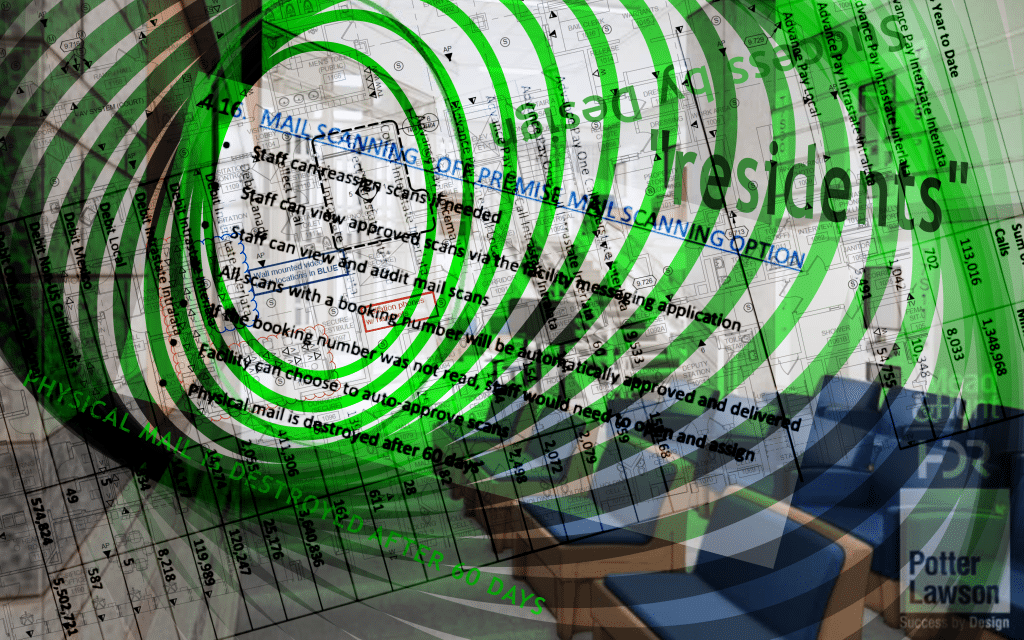
The grounds for scanning inmate mail are dubious, and vendors profit from the high price of connection.
The ACLU of Wisconsin sent out its annual holiday card in December. But no one on the organization’s mailing list actually received the physical card. Instead, recipients opened up an envelope to find a sad piece of copier paper, printed on either side with black-and-white scans of the card’s exterior and interior, plopped askew onto a scanner with its edges cut off. The front of the card depicts what might be an arrangement of pine boughs, against the background of a snowing sky. But the color, the texture, and the mix of cheer and solemn pangs the holiday season brings for so many of us have been ablated into greyscale purgatory.
An accompanying (and less festive) card explained that this is how mail looks for people incarcerated in Wisconsin’s state prisons. Across the country, prisons and jails have increasingly contracted with for-profit companies to scan inmate mail. Instead of their actual mail, prisoners increasingly receive a paper printout of the scans, or view scans on the tablets and kiosks (also provided by for-profit contractors) that are becoming ubiquitous across the American carceral system. The Wisconsin Department of Corrections began scanning mail in 2021, working with a popular contractor called TextBehind. The U.S. Bureau of Prisons began piloting the practice in 2020, and announced in fall 2024 that it would expand mail scanning to all federal prisons except for minimum-security facilities.
Soon, this could also be what mail will look like for people in the Dane County Jail. The Dane County Sheriff’s Office, which operates the jail, posted an RFP in late January for “communication services” at the jail, including mail scanning. This request also calls for phone, video-calling, and tablet services.
DCSO confirms to Tone Madison that it plans to adopt mail scanning, though the timeline and procedural specifics are not yet clear. An informational page on the jail’s website about inmate mail details which items are allowed and which are barred, but doesn’t discuss details about inspection procedures or the possibility of mail scanning in the near future.
The plan is news to at least some Dane County elected officials. Prompted by Tone Madison‘s inquiries for this story, members of the County’s Public protection and Judiciary Committee added a discussion of the RFP to the agenda for its Tuesday, February 25 meeting. The hybrid meeting takes place at 5:30 p.m. at Room 357 of the City-County Building (210 Martin Luther King Jr. Blvd.) and on Zoom.
In facilities that scan mail, incarcerated people usually don’t get to handle the physical mail that their correspondents and loved ones send them. They don’t get to experience the weight and texture of a postcard, the color of a children’s drawing, the details of a family photo. If the scan is poorly done, parts of a letter may be cut off, or too blurry to read. In some cases, inmates may end up paying fees to have their mail delivered on a proprietary tablet app. Civil-liberties groups, prisoners’-rights advocates, currently and formerly incarcerated people, and educational organizations like PEN America have repeatedly condemned the practice as dehumanizing. They point out that mail scanning cuts off prisoners from an important emotional lifeline. (Legal mail and other “privileged” mail can be inspected and scanned, but has more protection from interference, so scanning’s greatest impact is on personal correspondence.) It gives private contractors more opportunities to make money from people who already pay inflated prices for common food and personal-care items, phone calls, electronic messaging, money transfers, and access to various forms of media. That’s in addition to the obvious surveillance concerns it creates.
These same organizations also raise serious doubts about prison officials’ and contractors’ claims that the scanning process protects inmates and staff from dangerous drugs. Vera, a New York City-based nonprofit that opposes mass incarceration, pointed out in 2022 that the amount of contraband prison staffers smuggle into facilities often dwarfs the amount coming in through the mail. New restrictions on books and mail have often failed to slow the influx of contraband or prevent increases in sometimes-fatal overdoses.
This has not stopped the narrative from gathering steam. A bill introduced in the U.S. House of Representatives in 2023 calls for the U.S. Bureau of Prisons to “achieve 100 percent scanning capacity of mail arriving at all Federal correction facilities.” It’s called the Interdiction of Fentanyl in Postal Mail at Federal Prisons Act. The bill has yet to advance, but as Filter noted in 2024, it has continued to attract new co-sponsors from both parties, and has a counterpart bill in the Senate. In neighboring Illinois, the union representing state correctional officers has joined the push for mail scanning, largely citing concerns that mailed contraband endangers staff in the state’s prisons. A group of New York state prison employees currently conducting a wildcat strike have included mail scanning among their demands, also citing drug concerns.
It’s often difficult to get clear or verifiable statistics from prisons and jails about the amount of contraband detected in mail. The Wisconsin Department of Corrections cited contraband concerns as its rationale for tightening restrictions on books in 2024. When reporters asked for numbers, a DOC spokesperson replied that the agency recorded 881 “drug-related contraband incident reports” between January 2019 and September 18, 2024, of which 214 involved drugs on paper or drugs in the mail. But the way it described these alleged incidents varied in terminology from year to year.
DCSO also cites contraband among its reasons for seeking to adopt mail-scanning. “The rationale for seeking out this service is that it saves staff time, freeing them up to work on other things,” says DCSO spokesperson Elise Schaffer via email. “It also ensures that contraband is not coming into the jail. Our top priority in the jail is the safety of the residents and staff. This is one more way we can increase safety.” (Since August 2021, DCSO has officially referred to people incarcerated in the jail as “residents” rather than “inmates.” Sheriff Kalvin Barrett portrayed the change as part of an effort to humanize people who are incarcerated.)
Schaffer says that jail staff already inspects, by hand, “every piece of mail that comes into the Dane County Jail.”
Tone Madison replied, asking Schaffer if DCSO could provide any statistics on contraband making it into the jail via paper mail. Schaffer has not responded to that query as of this writing.
When asked about DCSO’s timeline for implementing the practice, Schaffer says: “The new scanning process was approved a while back, but there were some issues on the vendor’s side, so that portion of the contract was put on hold.”
Under elected officials’ radars
The Dane County Board of Supervisors did technically approve mail scanning in 2020 when signing off on the County’s current jail-communications contract with ViaPath (formerly known as Global Tel Link or GTL), which expires in May 2025. Whether they knew about it is a different question.
County ordinances require any “major” contract (defined as larger than $100,000, or larger than $40,000 in the case of public-works projects) to get approval from the County Board in the form of a resolution. The ViaPath contract calls for mail scanning services in addition to phone and video-call services, but the County amended it in 2022 to remove that provision.
The text of the County Board resolution authorizing that contract, however, doesn’t mention mail scanning—just phone and video services—though a draft contract attached to the resolution does mention mail scanning. The resolution passed unanimously at the County Board’s April 2, 2020 meeting. Supervisors and then-Sheriff Dave Mahoney had a brief discussion of the resolution at that meeting, but that didn’t touch upon mail scanning, either. This happened during the early days of Covid lockdown, so the focus was, understandably, on enabling inmates to stay in touch with their families.
District 6 Supervisor Yogesh Chawla submitted the version of the resolution that ultimately passed. Chawla’s substitute amendment moved back the project timeline, and required DCSO to report annually on fee revenues. At the time, Chawla voiced concerns about burdening inmates with high fees. He tells Tone Madison he opposes mail scanning, and apparently didn’t realize it was in the contract (or the new RFP) until reached for comment for this story.
“Jail Resident [sic] communications with friends, family, and the outside world is a vital support system for individuals both during and after incarceration,” Chawla writes in an emailed statement. “As the cost of communication technologies continues to decrease, there should be a concerted effort to make all voice and digital communication affordable, or ideally, free of charge. Under no circumstances should municipalities profit from the communication needs of incarcerated individuals.”
“Additionally, the County Board must thoroughly review any proposed changes to mail scanning practices to ensure that they strike a proper balance between safety and privacy, avoiding any further isolation of those who are incarcerated,” Chawla continues.
Mail scanning was also not top of mind for Supervisors as the long debate over funding an ever-more-expensive new Dane County Jail came to a head.
“That level of detail has not been discussed, not in any of the conversations that I have had,” says Dana Pellebon, who served as District 33 Supervisor from 2022 to 2024.
Pellebon played a crucial role in the Dane County Black Caucus effort to reduce the scope of the project, and helped secure reform commitments from DSCO. Ultimately, she joined a January 2024 vote approving funding for a larger project.
“Many of us believe that jails are inhumane, just full stop,” Pellebon says. “But if we are trying to inject points of humanity, things like contact with loved ones is an important piece, and there is a special relationship to being able to get mail.”
Pellebon doesn’t buy the claim that jails and prisons need to scan inmate mail in order to stop a rising tide of drug-tainted paper. “There’s no actual consolidated evidence that that stuff happens,” she says. “These are dog whistles. If there’s a huge problem…I’d like to see the data on that. I have not seen data that would support any of that.”
Barrett and his predecessor, Dave Mahoney, have consistently framed the project as a humanitarian improvement upon the current jail’s unsafe and outdated facilities. In 2013, Mahoney told The Cap Times that concerns for inmate mental health were among the important reasons for the project. “I will never stop advocating for a safe, humane, rehabilitative, and sustainable jail facility for our incarcerated residents and Sheriff’s Office staff,” Barrett declared in 2023. Earlier that year, Barrett attacked Supervisors for delaying approval of the project, accusing them of showing “a lack of empathy” for people in the jail.
During her time on the County Board, Pellebon wanted to reach compromises that moved the county toward a more humane and less carceral approach to public safety. Asked how mail scanning squares with those goals, Pellebon answers simply: it doesn’t.
“We know that folks that are in our Dane County jails, some of them have not been adjudicated yet. These are folks that haven’t even necessarily been convicted of a crime. To take away a piece of humanity just doesn’t feel like the Dane County way,” she says. “We can’t call our persons in that space ‘residents’ and not treat them with some basic respect.”
Tone Madison reached out to several current Supervisors and County Executive Melissa Agard’s office for this story. “Our office is aware that the Sheriff’s office has put out a Request for Proposals,” replies Aaron Collins, Agard’s Deputy Chief of Staff. “We don’t have any comment at this time and would direct questions to the Sheriff’s office.”
Some Supervisors did not respond by our deadline. Some were unable to talk on the record, simply because they hadn’t known about the mail-scanning plan.
High prices and mixed messages
The quality of the scans, and the costs to incarcerated people, will likely depend on which vendor gets the contract. The RFP does instruct bidders to provide services at “lowest possible cost to residents.”
That directive does have some legal teeth behind it, but only when it comes to some services. The Federal Communications Commission, in a July 2024 order, placed new restrictions on the often exorbitant fees and rates contractors can charge prisoners for audio and video calls. For a jail of Dane County’s size, it caps rates at 7 cents per minute for audio calls and 12 cents for video calls.
The new restrictions took effect on January 1, 2025 for larger prisons and jails, and are set to take effect on April 1 for jails with average daily populations of less than 1,000. Dane County falls into the latter category. Dane County’s video call prices have been left out of the RFP’s second appendix on pricing, but the jail’s website currently lists a rate of 25 cents per minute—more than twice the new FCC cap. Poor families of those incarcerated are paying $5 for a 20-minute virtual visit.
However, this new FCC ruling didn’t impact any costs related to mail. It also didn’t limit the costs prisoners pay for access to other services on tablets. Contractors and prison systems often distribute the tablets themselves for free, then charge inmates high rates for music-streaming subscriptions, ebooks, and other media. If anything, these hard limits on communication rates give contractors an incentive to expand their service options and charge higher rates to make up for the lost revenue from calls. Additionally, as the Trump Administration attempts to undermine the independence of the FCC and other federal agencies, the new regulations could be under threat.
Prices and the nature of delivery can vary depending on the prison system and its contractor. Currently, people in Wisconsin’s prisons pay around $10 for 500 minutes of use (around eight hours) for basic tablet services, including messaging, audiobooks, and music. And some have sued the state over losing access to music they had paid for when the Department of Corrections switched providers. While some incarcerated people might be able to choose between printed and digital options for mail, others might be stuck reading all their mail on a tablet or kiosk. In 2021, Florida prison officials proposed a compromise option: allowing inmates to pay an extra fee per-page to get their scanned mail printed out.
In addition to scanning mail that arrives via the U.S. Postal Service, prison contractors have created paid services that allow people to send messages digitally to inmates. These sometimes cost more than the postage for an equivalent mail item. TextBehind’s publicly listed rates start at $1.29 for text letters, greeting cards, and even a “Doodles4Kids” service that sends children’s drawings. Senders submit these materials digitally. Depending on the prison system and its agreement with TextBehind, the company then sends it on digitally to the facility, where staff can either pass it onto a prisoner’s tablet or print it out for them on-site. In the case of some prison systems—including the Wisconsin DOC—TextBehind prints the message out at a facility in Maryland, then physically ships it to the prison.
Another leading contractor in this space, Smart Communications, offers a variety of options through its SmartInmate portal. They include sending photos for $1 each, electronic messaging for 50 cents per message, and signing up to track postal mail sent to prisons. The latter is free but requires a government-issued ID. Securus, meanwhile, sells virtual “stamps,” which users then spend for various electronic messaging services. Sending one text-only message costs one stamp, adding photos or “eCards” costs one stamp a pop, a reply message costs one stamp, and so on. Securus sells the stamps “for between $0.17 and $0.33 apiece,” The Appeal reported in a 2023 story about the company repeatedly deleting prisoners’ draft emails in Washington State. The relatively smaller Pigeonly markets itself as a budget, subscription-based alternative to corrections-telecoms heavyweights like Securus and ViaPath. Pigeonly’s formerly incarcerated co-founder has even called out predatory pricing in the industry.
These companies almost always talk about their business models in compassionate terms, touting their services as an effort to connect incarcerated people with loved ones. “Our mission statement has always been to connect relationships from all over the world with a high dgree [sic] of convenience, efficiency, and affordability,” reads one passage on TextBehind’s About page. At times the branding comes off as an absurd taunt directed at prisoners: Pigeonly offers a “Forever Free Plan” and ViaPath’s messaging service, currently in use at the Dane County Jail, is literally named GettingOut.
As these nickel-and-diming, for-profit services spread, Wisconsin could play an important role in pushing back. Worth Rises, a national nonprofit that aims to dismantle the prison industry, has successfully pushed for communications to people in prisons to be free in several states through its “Connecting Families” campaign. WISDOM, a Wisconsin interfaith social-justice organization, has joined the campaign, and started a new statewide push in January of this year.
ACLU of Wisconsin spokesperson David Gwidt tells Tone Madison that his organization hasn’t yet had time to take a closer look at Dane County’s current RFP for jail communication services. Gwidt did share a statement via email about mail scanning in general:
“Receiving mail while incarcerated is incredibly meaningful. Incarcerated people often rely on physical mail correspondence to maintain relationships with their loved ones and stay connected to their lives on the outside,” Gwidt writes. “In a carceral environment that keeps those in custody isolated and separated from the people they care most about, physical mail allows people to feel the love and support from home. Staying connected has been shown to improve the mental and well-being [sic] of those incarcerated, reduce recidivism, and improve public safety.
“Scanning mail is dehumanizing and takes away the connection people get from mail that they can physically hold in their hands,” Gwidt continues. “Taking that away from a group of people who desperately need that connection is cruel and unnecessary.”
This post was originally published on this site be sure to check out more of their content.








